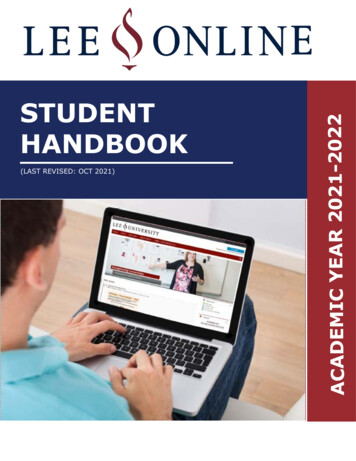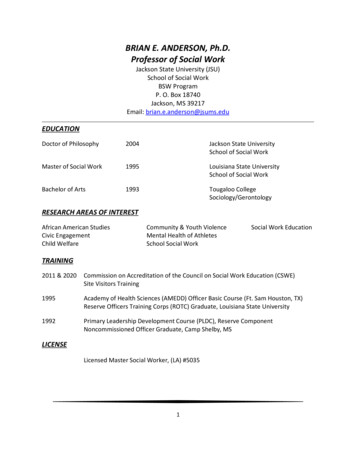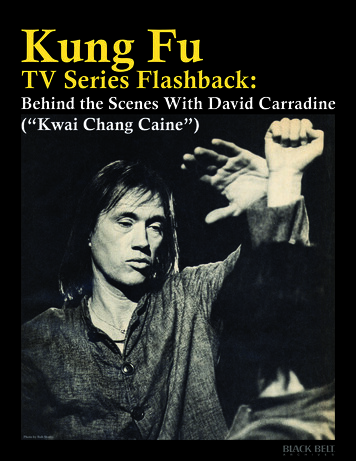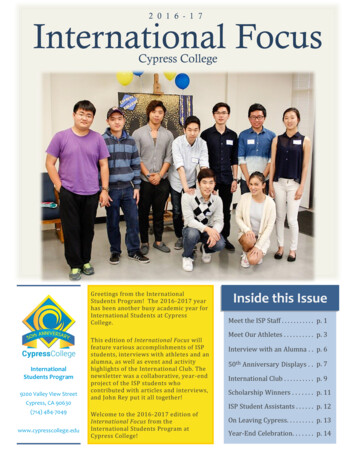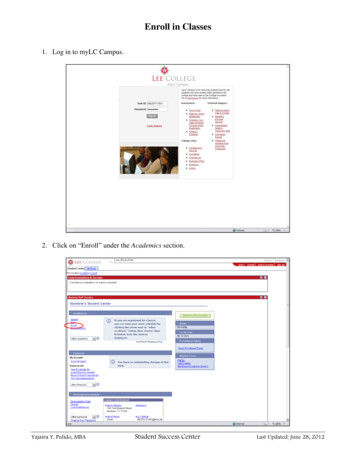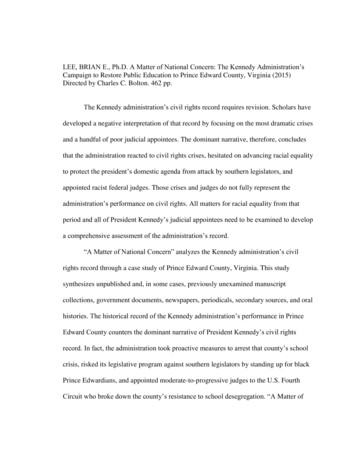
Transcription
LEE, BRIAN E., Ph.D. A Matter of National Concern: The Kennedy Administration’sCampaign to Restore Public Education to Prince Edward County, Virginia (2015)Directed by Charles C. Bolton. 462 pp.The Kennedy administration’s civil rights record requires revision. Scholars havedeveloped a negative interpretation of that record by focusing on the most dramatic crisesand a handful of poor judicial appointees. The dominant narrative, therefore, concludesthat the administration reacted to civil rights crises, hesitated on advancing racial equalityto protect the president’s domestic agenda from attack by southern legislators, andappointed racist federal judges. Those crises and judges do not fully represent theadministration’s performance on civil rights. All matters for racial equality from thatperiod and all of President Kennedy’s judicial appointees need to be examined to developa comprehensive assessment of the administration’s record.“A Matter of National Concern” analyzes the Kennedy administration’s civilrights record through a case study of Prince Edward County, Virginia. This studysynthesizes unpublished and, in some cases, previously unexamined manuscriptcollections, government documents, newspapers, periodicals, secondary sources, and oralhistories. The historical record of the Kennedy administration’s performance in PrinceEdward County counters the dominant narrative of President Kennedy’s civil rightsrecord. In fact, the administration took proactive measures to arrest that county’s schoolcrisis, risked its legislative program against southern legislators by standing up for blackPrince Edwardians, and appointed moderate-to-progressive judges to the U.S. FourthCircuit who broke down the county’s resistance to school desegregation. “A Matter of
National Concern” calls for Prince Edward County, and other civil rights cases, to beincluded in the Kennedy administration’s civil rights record.
A MATTER OF NATIONAL CONCERN: THE KENNEDY ADMINISTRATION’SCAMPAIGN TO RESTORE PUBLIC EDUCATION TOPRINCE EDWARD COUNTY, VIRGINIAbyBrian E. LeeA Dissertation Submitted tothe Faculty of the Graduate School atThe University of North Carolina at Greensboroin Partial Fulfillmentof the Requirements for the DegreeDoctor of PhilosophyGreensboro2015Approved byCommittee Chair
2015 Brian E. Lee
To Evie, AJ, and Lexi –You inspired me to raise the bar. Now it’s your turn to raise it further, to set a newstandard, to do it better and faster.ii
APPROVAL PAGEThis dissertation written by Brian E. Lee has been approved by the followingcommittee of the Faculty of The Graduate School at the University of North Carolina atGreensboro.Committee ChairCommittee MembersDate of Acceptance by CommitteeDate of Final Oral Examinationiii
TABLE OF CONTENTSPageLIST OF TABLES .vLIST OF FIGURES . viLIST OF ABBREVIATIONS . viiiCHAPTERI. INTRODUCTION: A NEW FRONTIER .1II. PROLOGUE – A DARK SPOT IN THE FREE WORLD:ROBERT F. KENNEDY’S VISIT TO PRINCE EDWARDCOUNTY, VIRGINIA, MAY 11, 1964 .8III. PART 1 .44IV. SAVE US FROM OURSELVES .49V. PART 2 .103VI. WE WILL MOVE .108VII. ARMED TRUCE .158VIII. WHO’S RESPONSIBLE? .205IX. WE ALL HAVE A RESPONSIBILITY .241X. TO SEE WHAT CAN BE DONE .290XI. PART 3 .361XII. MEN OF UNQUESTIONED ABILITY .363XIII. CONCLUSION .438BIBLIOGRAPHY . 446iv
LIST OF TABLESPageTable 4.1 Committees of the 87th Congress, First Session .100Table 9.1 President Kennedy’s Job Approval Rating .244Table 9.2 Discussants of School Situation with Peter Muirhead,March 1963 .260Table 9.3 Informal Discussion on Educational Matters in Prince EdwardCounty, Virginia, June 6, 1963 .276Table 9.4 Public Opinion of the Kennedy Administration’s Speed onIntegration .286Table 9.5 Responses of Negro Parents in Prince Edward County, Virginia,in June 1963, to the Question: “How do you think the schoolscan be opened again?” .289Table 10.1 Participants of the Second Meeting to Coordinate Federal andPrivate Agency Planning for Prince Edward County,July 16, 1963 .323Table 10.2 1963 Farmville Demonstrations List of Arrests .343Table 12.1 Judges of the U.S. Fourth Circuit Court of Appeals, 1951-1969.369Table 12.2 U.S. Fourth Circuit Court of Appeals’ School DesegregationOpinions, 1961-1966.419v
LIST OF FIGURESPageFigure 2.1 Map of Prince Edward County, Virginia .20Figure 2.2 Robert F. Kennedy at Longwood College .25Figure 2.3 Main Street in Farmville .28Figure 2.4 Robert F. Kennedy at Mary E. Branch ElementarySchool No. 2.32Figure 4.1 Prince Edward County Christian Association .57Figure 4.2 James Carter .60Figure 6.1 John F. Kennedy, February 8, 1961 .110Figure 6.2 Burke Marshall .119Figure 6.3 Frank D. Reeves .129Figure 6.4 “On Target” .148Figure 6.5 Robert F. Kennedy, May 6, 1961 .151Figure 7.1 “Getting in Bobby’s Hair” .160Figure 7.2 St. John Barrett .167Figure 7.3 Howard W. Smith .177Figure 7.4 Oliver Hill, Roy Wilkins, and L. Francis Griffin,May 20, 1961 .190Figure 7.5 Harrison-Godwin-Button Advertisement .199Figure 9.1 Robert F. Kennedy, March 18, 1963 .262Figure 9.2 John F. Kennedy, June 11, 1963.282Figure 10.1 Bill vanden Heuvel .293vi
Figure 10.2 Billy Watkins .297Figure 10.3 L. Francis Griffin .309Figure 10.4 Goodwin Douglas .327Figure 10.5 State Theater .330Figure 10.6 College Shoppe .333Figure 10.7 Farmville Baptist Church .336Figure 10.8 Fred Wallace .338Figure 10.9 Handbill .345Figure 10.10 Prince Edward Free School Association Announcement,August 14, 1963 .357Figure 12.1 Omnibus Judgeship Act, May 19, 1961 .366Figure 12.2 Albert Bryan and John Butzner .375Figure 12.3 J. Spencer Bell .378Figure 12.4 “Powhatan County Under Federal Dictatorship” .388Figure 12.5 Frank Reeves, Henry Marsh, and Samuel Tucker .400Figure 12.6 Midnight Raid on the Treasury.413Figure 12.7 Open Letter from Prince Edward County .430vii
LIST OF ABBREVIATIONSAFSCAmerican Friends Service Committee Archives, Philadelphia,PennsylvaniaALBPArmistead L. Boothe Papers, UVAASHPExecutive Papers of Albertis S. Harrison, Jr., 1962-1964, LVAASHP2Executive Papers of Albertis S. Harrison, Jr., 1964-1966, LVAAWRPA. Willis Robertson Papers, WMBAABaltimore Afro-AmericanBHPBrooks Hays Papers, JFKLBMPBurke Marshall Personal Papers, JFKLCBKPC. Brian Kelly Papers, UVACOREPPapers of the Congress of Racial Equality, 1941-1967 (microfilm)CRDTEACivil Rights During the Eisenhower Administration (microfilm)DBDanville BeeDHCDarrell Hodges Private Collection, Farmville, VirginiaDDELDwight D. Eisenhower Presidential Library, Abilene, KansasEHPPEdward H. Peeples, Jr. Papers, VCUFFAFord Foundation Archives, RACFFA2Field Foundation Archives, UTXAFHFarmville HeraldGFSPG. Frederick Switzer Papers, UVAviii
GWUEstelle and Melvin Gelman Library, George Washington University,Washington, D.C.HBPHelen Baker Papers, VCUHFBPHarry F. Byrd Papers, UVAHFBP2Harry F. Byrd, Jr. Papers, UVAHLBPHugo LaFayette Black Papers, LOCHMLPHeslip M. “Happy” Lee Papers, VCUHWPPapers of John F. Kennedy, Presidential Papers, White House Staff Filesof Harris WoffordHWSPHoward W. Smith Papers, UVAIUIndiana University, Ruth Lilly Special Collections & Archives,Indianapolis, IndianaJHDPJohn H. Daniel Papers, UVAJFKLJohn F. Kennedy Presidential Library, Boston, MassachusettsJFKPJohn F. Kennedy Papers, JFKLJFKOHJohn F. Kennedy Oral History Project, JFKLJLAPExecutive Papers of J. Lindsay Almond, Jr., LVAJLBBPJ.L. Blair Buck Papers, UVAJSBPJohn S. Battle Papers, UVAJSBP2Jesse Spencer Bell Papers, UNCCJSGPJ. Segar Gravatt Papers, UVALFPPLewis F. Powell, Jr. Papers, WLULNLynchburg Newsix
LOCLibrary of Congress, Washington, D.C.LVALibrary of Virginia, Richmond, VirginiaMRBFMary Reynolds Babcock Foundation, Winston-Salem, North CarolinaMSFMercy Seat Films, Richmond, VirginiaNAACPMNational Association for the Advancement of Colored People Records(microfilm)NAACPRNational Association for the Advancement of Colored People Records,LOCNARA-DCNational Archives, Washington, D.C.NARA-MDNational Archives, College Park, MarylandNARA-PANational Archives, Philadelphia, PennsylvaniaNEAANational Education Association Archives, GWUNVPNorfolk Virginian-PilotNYFRNew York Foundation Records, NYPLNYPLNew York Public Library, Stephen A. Schwarzman Building, New YorkNYTNew York TimesPCPittsburgh CourierPECCPrince Edward County Clerk’s Office, Farmville, VirginiaPEFSAPPapers of the Prince Edward Free School Association Papers, VSUPPIPetersburg Progress-IndexPPP-1961Public Papers of the Presidents of the United States: John F. Kennedy,1961 (Washington, DC: Government Printing Office, 1962).x
PPP-1962Public Papers of the Presidents of the United States: John F. Kennedy,1962 (Washington, DC: Government Printing Office, 1963).PPP-1963Public Papers of the Presidents of the United States: John F. Kennedy,1963 (Washington, DC: Government Printing Office, 1964).PWFRPublic Welfare Foundation Records, 1951-2004, IUPPSCPhyllis Padow Sederbaum Collection, QCQCQueens College, Rosenthal Library, Queens, New YorkRACRockefeller Archive Center, Sleepy Hollow, New YorkRBFARockefeller Brothers Fund Archives, RACRFARockefeller Foundation Archives, RACRG 12Record Group 12, Records of the Office of Education, NARA-MDRG 60Record Group 60, Records of the Department of Justice, NARA-MDRG 267Record Group 267, Records of the Supreme Court of the United States,NARA-DCRFKPRobert F. Kennedy Papers, Attorney General Papers, JFKLRNLRichmond News LeaderRTRoanoke TimesRTDRichmond Times-DispatchRWNRoanoke World NewsSCLCRRecords of the Southern Christian Leadership Conference, 1954-1970(microfilm)SESPSimon Ernest Sobeloff Papers, LOCSMLPSol M. Linowitz Papers, LOCxi
SPBPSarah Patton Boyle Papers, UVASRCPSouthern Regional Council Papers, 1944-1968 (microfilm)SSCStan Shaw Collection, QCSSNSouthern School NewsTCSPTheodore C. Sorensen Personal Papers, JFKLTBSPExecutive Papers of Thomas B. Stanley, LVAUNCCUniversity of North Carolina at Charlotte, J. Murrey Atkins Library,Charlotte, North CarolinaURUniversity of Richmond, Boatwright Library, Richmond, VirginiaUS4CCARecords of the U.S. Court of Appeals for the 4th Circuit, NARA-PAUSDCEDV-ARecords of the U.S. District Court of the Eastern District of Virginia,Alexandria Division, Civil Action Case Files, NARA-PAUSDCEDV-RRecords of the U.S. District Court of the Eastern District of Virginia,Richmond Division, Civil Action Case Files, NARA-PAUSDCEDLARecords of the U.S. District Court of the Eastern District of LouisianaUTXAUniversity of Texas at Austin, Briscoe Center for American History,Austin, TexasUVAUniversity of Virginia, Albert and Shirley Small Special CollectionsLibrary, Charlottesville, VirginiaUVALUniversity of Virginia, Arthur J. Morris Law Library, Charlottesville,VirginiaUVAPPapers of the University of Virginia President (Colgate Darden), UVAUWUniversity of Washington, Allen Library, Seattle, WashingtonVCUVirginia Commonwealth University, James Branch Cabell Library,Richmond, Virginiaxii
VSNPVictor S. Navasky Personal Papers, JFKLVSUVirginia State University, Johnston Memorial Library, Petersburg,VirginiaVTAPVirginia Teachers’ Association Papers, VSUWAAWashington Afro-AmericanWEFPWalter E. Fauntroy Papers, GWUWESWashington Evening StarWGMPWarren Grant Magnuson Papers, UWWHCNFWhite House Central Name Files, JFKP, JFKLWHCSFWhite House Central Subject Files, JFKP, JFKLWLUWashington & Lee University, Lexington, VirginiaWMCollege of William & Mary, Earl Gregg Swem Library, Williamsburg,VirginiaWMAPWatkins M. Abbitt Papers, URWMTPWilliam Mumford Tuck Papers, WMWPWashington Postxiii
CHAPTER IINTRODUCTION: A NEW FRONTIERThe Kennedy administration’s civil rights record requires revision. The prevailinginterpretation determines that the administration reacted to civil rights crises, wavered onracial issues to safeguard its domestic agenda against attacks from southern legislators,and appointed racist judges to the federal bench. Scholars have drawn theseinterpretations by focusing on the most dramatic crises of that time and a handful of poorjudicial appointees. Those crises and judges do not fully represent the administration’scivil rights record, nor should they obscure hundreds, if not thousands of unchronicledlocal struggles for racial equality. The untold stories represent the new frontier ofKennedy scholarship. It requires that all civil rights struggles and judicial appointees beexamined. Only then can scholars develop a comprehensive assessment of the Kennedyadministration’s civil rights record. That record must include Prince Edward County,Virginia.11Brian E. Lee, “A New Frontier: Reevaluating JFK’s Civil Rights Record Through a Case Study ofPrince Edward County, Virginia,” Federal History, No. 7 (2015): 53-66.1
John F. Kennedy “literally shook his head with incredulity” when he learned thatPrince Edward County abandoned public education.1 The county school board, a litigantin the landmark Brown v. Board of Education case, had been under court order todesegregate its public schools “with all deliberate speed.” After years of legal challenges,a federal appeals court ordered the school board to begin desegregating its schools bySeptember 1959. In defiance of that order, the county board of supervisors refused to levytaxes to operate schools, marking Prince Edward County as the only locale in the nationwithout free public education. Segregationist leaders improvised a private school systemfor the fourteen hundred white children. However, the county provided no educationalprogram for the seventeen hundred black children, forcing hundreds to leave home, andmany the state, to live with family, friends, or strangers to obtain a “bootleg” education.Hundreds more remained in the county without formal schooling for four years.2 TheKennedy administration inherited the Prince Edward County school situation, a crisis thatthreatened to intellectually and economically cripple a generation and, if replicated,destabilize the American institution of public education.1Theodore C. Sorensen, Kennedy (New York: Harper & Row, 1965), 480. Ted Sorensen, specialcounsel to the president, did not specify when Kennedy learned that Prince Edward County abandonedpublic education. It is unclear, therefore, if Sorensen witnessed Kennedy’s reaction before or after hebecame president. In their memoir, Ken O’Donnell and Dave Powers remembered that Kennedy “devouredevery newspaper and newsmagazine that he could get his hands on.” Conceivably, Kennedy followed themedia’s coverage of the Prince Edward matter. See Kenneth P. O’Donnell and David F. Powers, “Johnny,We Hardly Knew Ye”: Memories of John Fitzgerald Kennedy (Boston: Little, Brown and Company, 1970),408.2Brown v. Board of Education, 347 U.S. 483 (1954), 349 U.S. 294 (1955); Allen v. County Board ofPrince Edward County, 266 F.2d 507 (4th Cir. 1959); “Private Schools Seen Answer to Court’s IntegrationOrder: Educational Corp. Affirms Plans for Private Schools,” FH, May 8, 1959, 1; Minutes, Prince EdwardCounty Board of Supervisors, June 1959, PECBOSR; Robert L. Green and Louis Hofmann, “ProgressReport,” June 30, 1963, Box 100, RG 12.2
Historians have overlooked the Kennedy administration’s efforts in PrinceEdward County. The school crisis has appeared in scholarship on civil rights and Virginiahistory. In those works, the administration’s role may receive a fleeting passage, if anymention at all. Likewise, the Kennedys have been the subject of countless monographsbut biographers have only permitted the school closings a brief mention, if any coverageat all. The absence of violence and spectacle may explain the lack of scholarly interest.The civil rights stories that drive the dominant narrative provide a contrast. Whitesupremacists firebombed a Greyhound bus carrying Freedom Riders outside Anniston,Alabama. In Prince Edward County, the school buses stood idly in a parking lot.President Kennedy sent troops to restore order at the University of Mississippi. No troopswere required in Prince Edward County. Birmingham furnished iconic images andtelevision footage. The school closings bequeathed posterity lifeless stills and stockfootage of vacant buildings, nothing worthy apparently for inclusion in the iconic civilrights documentary Eyes on the Prize. The Prince Edward school litigation offered noracial vitriol from the federal bench, just hearing after hearing without a resolution. Theslender amount of published scholarship on Prince Edward County and the even thinnercoverage of the Kennedy administration’s involvement fail to match the magnitude of theepisode’s significance.Robert C. Smith laid the foundation for scholarship on the Prince Edward Countyschool closings. Smith, a journalist for the Norfolk Virginian-Pilot, interviewed the majorplayers as events unfolded. Those interviews represent his book’s greatest contribution to3
the historical record. They Closed Their Schools: Prince Edward County, Virginia, 19511964 (1965) provided a solid first draft of the school struggle, but not the final word.Smith’s work was constrained by the unavailability of sources. In the half-century sinceits publication, manuscript collections and government records have been opened toscholars, revealing a wealth of evidence that was inaccessible in the 1960s. In the recentdecades, doctoral students have built upon Smith’s work by exploring those untappedsources, conducting oral history interviews, and writing pioneering dissertations. KaraMiles Turner broadened our understanding of the school closings by examining the longcivil rights movement in Prince Edward County from Reconstruction through thetwentieth century. Amy Tillerson focused her dissertation on the role of black womenactivists there from the Great Depression through the school closings. In addition, theyboth contributed article-length publications that further demonstrated the need to updateThey Closed Their Schools.3Jill Ogline Titus and Chris Bonastia produced new monographs on the schoolclosings. In Brown’s Battleground: Students, Segregationists, and the Struggle for Justice3Robert C. Smith, They Closed Their Schools: Prince Edward County, Virginia, 1951-1964 (ChapelHill: University of North Carolina Press, 1965); Kara Miles Turner, “‘It is Not at Present a Very SuccessfulSchool’: Prince Edward County and the Black Educational Struggle, 1865-1995” (Ph.D. diss., DukeUniversity, 2001); Amy J. Tillerson, “Negotiating Intersections of Gender, Social Class, and Race: BlackWomen in Prince Edward County, Virginia, Activists, and Community Builders, 1930-1965” (Ph.D. diss.,Morgan State University, 2006); Kara Miles Turner, “Both Victors and Victims: Prince Edward County,Virginia, the NAACP, and Brown,” Virginia Law Review, 90, No. 6 (October 2004): 1667-1691; KaraMiles Turner, “Liberating Lifescripts: Prince Edward County, Virginia, and the Roots of Brown v. Board ofEducation,” in In From the Grassroots to the Supreme Court: Brown v. Board of Education and AmericanDemocracy, edited by Peter F. Lau (Durham: Duke University Press, 2004), 88-104; Amy TillersonBrown, “‘Grassroots Schools’ and Training Centers in the Prospect District of Prince Edward County,Virginia, 1959-1964,” in The Educational Lockout of African Americans in Prince Edward County,Virginia (1959-1964), Personal Accounts and Reflections, edited by Terence Hicks and Abul Pitre(Lanham, Maryland: University Press of America, 2010), 1-17.4
in Prince Edward County, Virginia (2011), a revision of her dissertation, Titus utilizedunpublished archival documents, with an emphasis on detailed memoranda of civil rightsworkers, to reconstruct the period of the school closings. Bonastia, a sociology professorat Lehman College, used an even wider breadth of sources in Southern Stalemate: FiveYears without Public Education in Prince Edward County, Virginia (2012) to determinewhy Prince Edward County closed its public schools. Brown’s Battleground andSouthern Stalemate both updated They Closed Their Schools by incorporating newevidence and extending the story to the present.4Titus and Bonastia both provided chapter-length assessments of the Kennedyadministration’s response to the school closings. Their interpretations conform neatlywith the dominant narrative of the administration’s civil rights record. Titus argues thatthe Department of Justice was so consumed with reacting to other civil rights crises that itcould not adequately address Prince Edward County. In fact, Titus contends that AttorneyGeneral Robert F. Kennedy did not recognize the “gravity of the situation” until March1963. Bonastia acknowledges the administration’s concern for the locked-out children,but determined that it was “tempered by its reluctance to antagonize powerful Southern4Jill Ogline Titus, Brown’s Battleground: Students, Segregationists, and the Struggle for Justice inPrince Edward County, Virginia (Chapel Hill: University of North Carolina Press, 2011); Jill L. Ogline, “AMission to a Mad County: Black Determination, White Resistance and Educational Crisis in Prince EdwardCounty, Virginia” (Ph.D. diss., University of Massachusetts at Amherst, 2007); Christopher Bonastia,Southern Stalemate: Five Years without Public Education in Prince Edward County, Virginia (Chicago:University of Chicago Press, 2012).5
politicians.”5 This study, the first full-length study of the Kennedy administration’sperformance in Prince Edward County, questions those assertions.“A Matter of National Concern” argues that the Kennedy administration’sresponse to the school closings counters the dominant narrative. First, the administrationtook proactive measures to restore universal education to Prince Edward County.Kennedy’s Department of Justice worked to enter the litigation at the earliest possibledate, at every level of the federal judiciary. The glacial pace of litigation delayed justicefor black Prince Edwardians. As a fifth year of closed schools loomed, the administrationspearheaded an extraordinary effort to mitigate the educational deprivation: theestablishment of a temporary private school system available to all school-age countyresidents. Second, the administration confronted powerful southern congressmen bydefending the locked-out children. The county’s segregationists represented the coreconstituency of the dominant political faction in Virginia. That faction, the ByrdOrganization, had the influence in Congress to undermine President Kennedy’slegislative agenda – and they did just that in the name of federal interference in PrinceEdward County. Finally, Kennedy’s judicial appointees took progressive action in thePrince Edward litigation. In fact, those judges broke down the last vestiges of Virginia’s“massive resistance” to school desegregation and delivered a mortal wound to the ByrdOrganization. From the beginning, the Kennedy administration considered the school5Titus, Brown’s Battleground, 133-159; Bonastia, Southern Stalemate, 17, 133-160.6
closings, as Assistant Attorney General Burke Marshall stated, “a matter of nationalconcern.”66Burke Marshall to Milton A. Reid, May 5, 1961, Reel 105, RG 60.7
CHAPTER IIPROLOGUE – A DARK SPOT IN THE FREE WORLD:ROBERT F. KENNEDY’S VISIT TO PRINCE EDWARD COUNTY, VIRGINIA,MAY 11, 1964In the six months after the assassination, Arlington National Cemeteryexperienced a staggering increase in visitors. Three thousand callers per hour throngedthe trail to John F. Kennedy’s gravesite, a six hundred square foot plot framed by a shortpicket fence. Mourners paused to pay their respects. They sang and prayed, left flowersand trinkets, and gazed at the orange flame flickering in the wind atop the mound ofevergreens. Meditations on what might have been were etched across their faces. “In theworld of their dreams,” presumed James Reston of the New York Times, “Presidentswould be young and heroic with beautiful wives, and the ugly world would betransformed by their examples.” Kennedy changed the image of the presidency, but moreimportantly he imbued a spirit of morality, energy, and idealism. He encouraged theAmerican people to embrace equality, inspired a nation to reach for the heavens, andexhorted a dangerous world to pursue peace. Lyndon Johnson inherited the presidency8
but not the Kennedy promise. That had been shattered in Dallas. Only Robert F. Kennedycould collect the shards and carry out his brother’s legacy, but he too was shattered.1Robert Kennedy suffered through a long period of depression. He not only lost hisbrother but the man to whom he devoted much of his life. Kennedy had managed hisbrother’s political campaigns with single-minded focus and served as attorney generaldoggedly committed to the president’s interests. “His whole life was wrapped up in thePresident,” explained Ethel Kennedy, the attorney general’s wife. “Bobby never thoughtabout himself – or his own life. So when the President died – well, it was like part ofBobby died, too.” Kennedy’s grief ran soul deep. “There was a void in his life, a woundthat never healed,” remembered a friend. “Anyone who looked into his eyes knew thesuffering he endured.” The emotional crucible had also taken a physical toll. Kennedy’sathletic frame became gaunt, the unruly shock of light-brown hair grayed, and lines ofgrief framed his piercing blue eyes. T
SRCP Southern Regional Council Papers, 1944-1968 (microfilm) SSC Stan Shaw Collection, QC SSN Southern School News TCSP Theodore C. Sorensen Personal Papers, JFKL TBSP Executive Papers of Thomas B. Stanley, LVA UNCC University of North Carolina at Charlotte, J. Murrey Atkins Library, Charlotte, North Carolina


